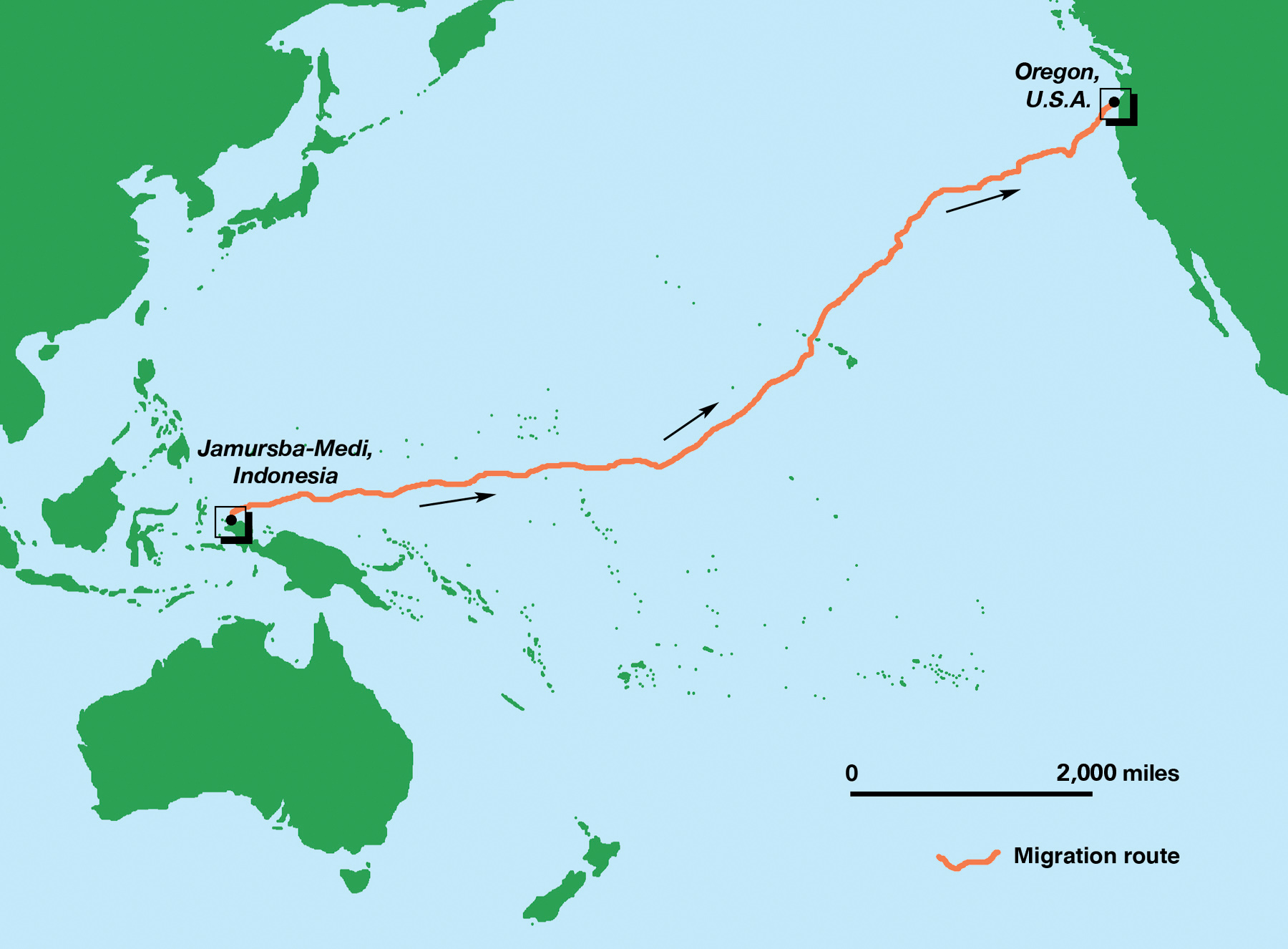Pacific Leatherback Sets Long-Distance Record
This map illustrates the migration of one female leatherback turtle, after nesting in Jamursba Medi, Papua, Indonesia, to foraging grounds off the coast of Oregon, United States— a distance of 20,558 kilometers (12,774 miles). © Stephen Nash / Conservation International
By Dr. Peter Dutton, Scott Benson, and Creusa “Tetha” Hitipeuw
It has long been known that leatherbacks are the most widely distributed marine reptile on our planet. They have been seen in the frigid waters off Argentina, southern Chile, and Tasmania and are not uncommon in the subarctic northern latitudes off Alaska, Nova Scotia, and the North Sea. Adults migrate periodically from these temperate foraging habitats to tropical breeding grounds, and a growing body of scientific research is yielding information on the migratory routes and geographic links between these areas. In the Pacific, where leatherback populations continue to decline, we urgently need to understand where these creatures spend their lives at sea in order to mitigate human-induced threats.
The National Marine Fisheries Service, Southwest Fisheries Science Center, leads a program with international partners in Indonesia, Papua New Guinea, and the Solomon Islands. The program uses increasingly sophisticated molecular, genetics, and satellite-tracking tools. Early genetics results showed that the leatherbacks living in the North Pacific, including waters near the U.S. west coast, are part of the western Pacific breeding population.
Leatherbacks can dive up to a mile deep and can cross thousands of miles of ocean in a year. © TAMAR - IBAMA
Those results have now been confirmed by a trans-Pacific satellite track of a nester, tagged on Jamursba-Medi beach in Papua, Indonesia, which made the trans-Pacific odyssey to the foraging area off the coast of Oregon, United States, and back westward. This female leatherback was tracked for 647 days over a minimum distance of 20,558 kilometers (12,774 miles) before the signal was lost. This distance set a new record for sea turtles—among the longest documented migrations between breeding and foraging areas by any marine vertebrate (see map at left).
Additional research is showing that nesters from the western Pacific metapopulation, the last sizable nesting population remaining in the Pacific, migrate through areas in the Philippines, South China Sea, and Japan, into the Southern Hemisphere. As such, sea turtle populations are often the shared responsibility of several nations. The urgency for protecting leatherbacks in the Pacific, in particular, has served as a catalyst to develop an internationally coordinated conservation strategy.
In July 2007, the second Bellagio Sea Turtle Conservation Initiative workshop convened in Terengganu, Malaysia, to develop a strategic plan to guide the prioritization and long-term financing of Pacific leatherback turtle conservation and recovery objectives. Forty five experts on sea turtles, fisheries, conservation, and finance from 10 countries gathered to discuss the priorities for the western Pacific leatherback nesting populations as one component of a broader pan-Pacific plan.
The Pacific leatherback turtle has drawn teams of dedicated people to its cause. The conservation fund planned during this workshop will make it possible for stakeholders to engage in long-term planning and avoid the risk that critical conservation investments made in some years will be lost in others when funding is low.
Meanwhile, we continue to track leatherbacks and other sea turtle species to discover what areas are most critical to their survival.
This article originally appeared in SWOT Report, vol. 3 (2008). Click here to download the entire article as a PDF.


